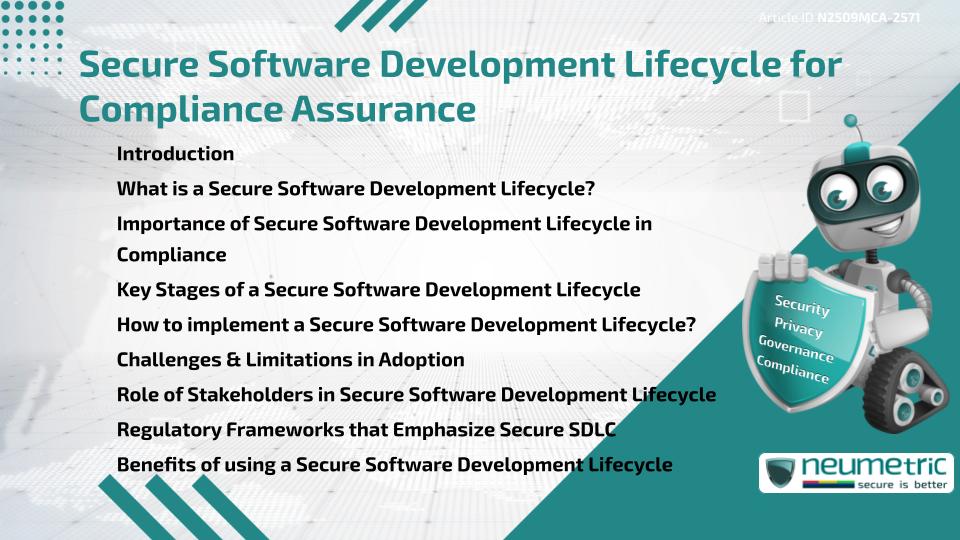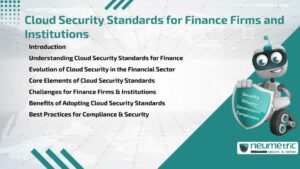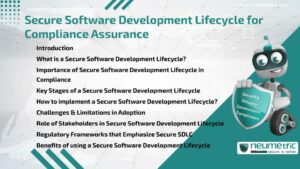Table of Contents
ToggleIntroduction
A secure software development lifecycle is an approach that integrates security practices into every phase of software creation, from planning to deployment & maintenance. It ensures that applications are designed with security in mind, reducing Vulnerabilities & aligning with Compliance Requirements. This article explores what a secure software development lifecycle is, its importance for compliance, the key stages involved & how Organisations can implement it effectively.
What is a Secure Software Development Lifecycle?
A secure software development lifecycle is a methodology that embeds security checkpoints within the traditional software development process. Instead of testing for Vulnerabilities only at the end, it introduces Security Measures at planning, design, coding, testing & release. This approach helps detect & mitigate Risks early, saving costs & enhancing trust.
Importance of Secure Software Development Lifecycle in Compliance
Organisations today operate under strict regulations such as GDPR, HIPAA & PCI DSS. These frameworks require strong controls over Data Privacy & system security. Adopting a secure software development lifecycle ensures that applications meet compliance standards by preventing unauthorized access, securing Sensitive Data & reducing the Risk of breaches. For businesses in Finance, Healthcare & e-commerce, this practice is not optional but essential.
Key Stages of a Secure Software Development Lifecycle
The secure software development lifecycle typically includes:
- Planning: defining objectives, Risk analysis & Compliance Requirements.
- Design: integrating secure architecture, Threat modeling & security principles.
- Development: applying Secure Coding Practices & code reviews.
- Testing: performing static & dynamic analysis, Penetration Testing & validation.
- Deployment: ensuring configurations are hardened & Vulnerabilities are minimized.
- Maintenance: Continuous Monitoring, updates & Patch Management.
How to implement a Secure Software Development Lifecycle?
To adopt this Framework effectively, Organisations can:
- Train teams: provide developers & testers with secure coding & compliance training.
- Adopt tools: use automated scanners, code analyzers & Monitoring Tools.
- Collaborate: foster cooperation between security teams, developers & compliance officers.
- Establish Policies: define security guidelines & enforce consistent standards.
- Iterate continuously: regularly update practices to adapt to evolving Threats.
Challenges & Limitations in Adoption
While beneficial, implementing a secure software development lifecycle can face challenges. Small Organisations may lack resources to invest in training & tools. Development teams may resist change due to time constraints. Additionally, overemphasis on compliance without addressing real Risks may lead to a checkbox mentality rather than genuine security.
Role of Stakeholders in Secure Software Development Lifecycle
Effective adoption requires commitment from all Stakeholders. Developers must follow Secure Coding Practices, security teams should provide guidance & testers must validate Vulnerabilities. Compliance officers ensure that Regulatory Standards are addressed, while management provides the necessary resources. This collective approach ensures that security is embedded, not bolted on.
Regulatory Frameworks that Emphasize Secure SDLC
Several compliance frameworks highlight the need for secure software development. For instance, NIST Cybersecurity Framework & ISO/IEC 27034 provide guidance for integrating security in development. Similarly, PCI DSS requires Secure Coding Practices & HIPAA mandates strong protection of Healthcare data.
Benefits of using a Secure Software Development Lifecycle
The secure software development lifecycle provides multiple advantages:
- Reduces Vulnerabilities early in development.
- Ensures alignment with compliance standards.
- Builds Customer Trust by safeguarding Sensitive Data.
- Saves costs by preventing expensive post-release fixes.
- Creates a culture of security awareness across teams.
Takeaways
- A secure software development lifecycle embeds security into every phase of development.
- It helps Organisations meet compliance obligations & reduce Risks.
- Key elements include planning, design, development, testing, deployment & maintenance.
- Collaboration & training are vital for successful adoption.
FAQ
What is the purpose of a secure software development lifecycle?
Its purpose is to ensure security is integrated into every phase of development, reducing Risks & supporting compliance.
Is a secure software development lifecycle mandatory for compliance?
While not always explicitly required, most compliance frameworks strongly encourage or indirectly mandate it.
What industries benefit most from a secure software development lifecycle?
Industries handling Sensitive Data, such as Finance, Healthcare & e-commerce, benefit significantly.
What tools support a secure software development lifecycle?
Automated code analyzers, Vulnerability scanners & Monitoring Tools support implementation.
How does a secure software development lifecycle reduce costs?
By addressing Vulnerabilities early, it avoids expensive fixes & potential breach penalties.
Can Small Businesses adopt a secure software development lifecycle?
Yes, but they may implement a scaled-down version suited to their resources.
How does it differ from traditional software development?
Unlike traditional approaches, it integrates Security Measures throughout rather than only at the end.
Need help for Security, Privacy, Governance & VAPT?
Neumetric provides organisations the necessary help to achieve their Cybersecurity, Compliance, Governance, Privacy, Certifications & Pentesting needs.
Organisations & Businesses, specifically those which provide SaaS & AI Solutions in the Fintech, BFSI & other regulated sectors, usually need a Cybersecurity Partner for meeting & maintaining the ongoing Security & Privacy needs & requirements of their Enterprise Clients & Privacy conscious Customers.
SOC 2, ISO 27001, ISO 42001, NIST, HIPAA, HECVAT, EU GDPR are some of the Frameworks that are served by Fusion – a SaaS, multimodular, multitenant, centralised, automated, Cybersecurity & Compliance Management system.
Neumetric also provides Expert Services for technical security which covers VAPT for Web Applications, APIs, iOS & Android Mobile Apps, Security Testing for AWS & other Cloud Environments & Cloud Infrastructure & other similar scopes.
Reach out to us by Email or filling out the Contact Form…





